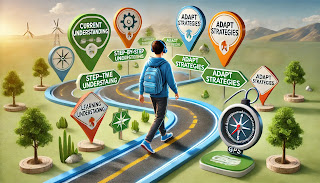Feedback
Feedback of Learning: Reflecting on the Journey
"Feedback of learning" refers to summative feedback, typically delivered after an educational experience. It provides a holistic evaluation of a student's performance, assessing what they did well, what needs improvement, and what may have been overlooked. This type of feedback offers a comprehensive overview, enabling learners to reflect on their overall journey.
For instance, after completing a project or a module, summative feedback can guide a student by pinpointing strengths, such as their ability to present ideas clearly or their effective use of data and research. These affirmations reinforce what the student has mastered, building confidence in those areas.
At the same time, summative feedback identifies areas for improvement, such as the need to strengthen analytical thinking, improve time management, or refine communication skills. It also highlights what may have been overlooked, such as research gaps, misaligned objectives, or structural issues in their work. For example, a student might need to address specific vital theories or have backed their claims with sufficient evidence.
This feedback acts as a roadmap for future endeavours. By understanding both their strengths and weaknesses, students can approach similar projects with greater awareness, making more informed decisions and avoiding past mistakes. In this way, feedback on learning offers closure while also providing forward-thinking guidance that helps learners continuously improve and evolve.
Feedback for Learning: A Guiding Light Throughout the Process
In contrast, "feedback for learning" is formative and is provided throughout the learning process, not just at the end. Its role is to guide and shape the student’s learning journey, offering insights on what they have done well so far, areas where they need to improve, and potential oversights that could hinder their progress. This feedback type is ongoing, providing a constant source of direction and encouragement.
Formative feedback, like GPS, helps students stay on course by offering real-time corrections. For example, feedback might commend the student for effectively capturing the main argument during a writing assignment while suggesting improvements in organisation and clarity. It might also point out an overlooked aspect, such as failing to address counterarguments or not supporting claims with enough evidence.
Providing formative feedback like a GPS for students, guiding them through their learning journey. Here’s how the analogy works:
Starting Point (Current Understanding): Just like a GPS identifies the starting location, formative feedback helps students recognise where they are in their learning. It provides insights into their current strengths and weaknesses.
Destination (Learning Goals): The GPS sets the destination, just as formative feedback aligns with the student’s learning objectives. The feedback clarifies what they need to achieve and provides clear goals.
Turn-by-Turn Directions (Step-by-Step Guidance): GPS offers continuous instructions to keep the driver on track and make real-time adjustments. Similarly, formative feedback gives students immediate, actionable guidance to help them improve and stay on the right path.
Rerouting (Adapting Strategies): The GPS recalibrates if a driver takes a wrong turn. Formative feedback works the same way, helping students course-correct by addressing misconceptions or mistakes and giving them alternative strategies to succeed.
Milestones and Checkpoints (Progress Monitoring): Just as GPS systems inform drivers about their progress, formative feedback provides checkpoints where students can reflect on what they've achieved so far and what still needs improvement.
Encouragement Along the Way (Positive Reinforcement): GPS systems give updates on how far the driver has come, and formative feedback offers praise for effort and progress, motivating students to keep going.
This immediate feedback is crucial because it allows students to adjust as they go rather than wait until the task's end. By identifying their strengths and weaknesses early, students can refine their work, correct errors, and avoid potential pitfalls. For instance, a student might have a strong thesis but may need to work on the logical flow of their essay, or they might excel at creative problem-solving but overlook foundational details.
Furthermore, peer feedback is invaluable in this formative process. By receiving feedback from classmates, students gain new perspectives and identify blind spots they may not have noticed. Peer feedback often points out what others are doing well, encourages mutual learning, and offers constructive advice on what can be improved or revisited.
In this way, feedback for learning plays a critical role in actively shaping the learning experience. It helps students stay engaged, take ownership of their progress, and continuously develop their skills throughout the learning process. By integrating both educator and peer feedback, students are empowered to create more meaningful, high-quality work.







No comments:
Post a Comment